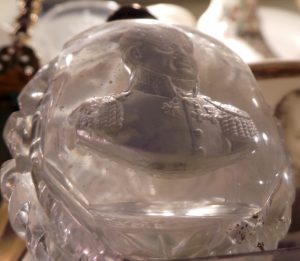
-
GLASS SULPHIDES SCENT BOTTLE WITH PORTRAIT OF KING WILLEM I
Glass sulphides, also called Cameo Incrustations, are opaque, usually white, medallions or figurines encased in glass and used to decorate clear glass objects. They often appear on the sides of decanters, jugs, bottles and tumblers. The name sulphide comes from the use of sulphur in the process of manufacturing sulphides in the late 18th and early 19th centuries. The sulphide itself is usually made from a clay (or ceramic) and glass paste and is completely encased in glass. The early 19th century patents (innovative English glassmaker Apsley Pellatt (1791-1863) in 1819 in England and Pierre Honore Boudon de Saint-Amans in1818 in France) involved opening up a blown glass bulb while it was still molten, and placing the sulphide inside, then sealing up the opening (by pinching together the molten glass) and sucking out the air to draw the glass and the sulphide together. The most famous and successful producers of sulpides were Apsley Pellat in England from 1819 to the mid-century followed by Baccarat in France. Sulphides are sometimes called “Cameo Incrustations” or “Cameo Encrustations” and Apsley Pellatt originally called them “Crystallo-Ceramie”.
This glass scent bottle has a portrait of King Willem I and was probably made in France in 1813 :

- glass sulphides scent bottle with portrait King Willem I ca 1813
info: georgiani.net















